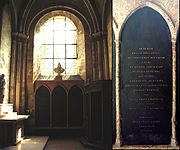
Saint-Germain-des-Prés
Encyclopedia

VIe arrondissement
The 6th arrondissement of Paris is one of the 20 arrondissements of the capital city of France. It includes world famous educational institutions such as the École des Beaux-Arts de Paris and the Académie française, the seat of the French Senate as well as a concentration of some of Paris most...
of Paris, France, located around the church of the former Abbey of Saint-Germain-des-Prés
Abbey of Saint-Germain-des-Prés
The Benedictine Abbey of Saint-Germain-des-Prés, just beyond the outskirts of early medieval Paris, was the burial place of Merovingian kings of Neustria...
.
Home to a number of famous cafés, such as Les Deux Magots
Les Deux Magots
Les Deux Magots is a famous café in the Saint-Germain-des-Prés area of Paris, France. It once had a reputation as the rendezvous of the literary and intellectual élite of the city. It is now a popular tourist destination...
and Café de Flore
Café de Flore
The Café de Flore, at the corner of the Boulevard Saint-Germain and the Rue St. Benoit, in the 6th arrondissement of Paris, has long been celebrated for its intellectual clientele....
, the Saint-Germain-des-Prés area was the center of the existentialist movement (associated with Jean-Paul Sartre
Jean-Paul Sartre
Jean-Paul Charles Aymard Sartre was a French existentialist philosopher, playwright, novelist, screenwriter, political activist, biographer, and literary critic. He was one of the leading figures in 20th century French philosophy, particularly Marxism, and was one of the key figures in literary...
and Simone de Beauvoir
Simone de Beauvoir
Simone-Ernestine-Lucie-Marie Bertrand de Beauvoir, often shortened to Simone de Beauvoir , was a French existentialist philosopher, public intellectual, and social theorist. She wrote novels, essays, biographies, an autobiography in several volumes, and monographs on philosophy, politics, and...
).
Transportation
The area is served by the stations of the Paris MétroParis Métro
The Paris Métro or Métropolitain is the rapid transit metro system in Paris, France. It has become a symbol of the city, noted for its density within the city limits and its uniform architecture influenced by Art Nouveau. The network's sixteen lines are mostly underground and run to 214 km ...
:
- Saint-Germain-des-PrésSaint-Germain-des-Prés (Paris Metro)Saint-Germain-des-Prés is a station on line 4 of the Paris Métro, serving the Saint-Germain-des-Prés area in the heart of the Left Bank in the 6th arrondissement....
- MabillonMabillon (Paris Metro)Mabillon is a station on line 10 of the Paris Metro in the heart of the Left Bank and the 6th arrondissement.The station opened on 10 March 1925 as part of the line's extension from Croix Rouge . It was the eastern teminus of the line until its extension to Odéon on 14 April 1926...
Literature
Many writers have written about this Parisian district in prose such as Boris VianBoris Vian
Boris Vian was a French polymath: writer, poet, musician, singer, translator, critic, actor, inventor and engineer. He is best remembered today for his novels. Those published under the pseudonym Vernon Sullivan were bizarre parodies of criminal fiction, highly controversial at the time of their...
, Gabriel Matzneff (see La Nation française
La Nation française
La Nation française was a French monarchist weekly influenced by Charles Maurras, the founder of the Action française movement...
), Jean-Paul Caracalla or in Japanese poetry
Japanese poetry
Japanese poets first encountered Chinese poetry during the Tang Dynasty. It took them several hundred years to digest the foreign impact, make it a part of their culture and merge it with their literary tradition in their mother tongue, and begin to develop the diversity of their native poetry. For...
in the case of Nicolas Grenier.
See also
- Boulevard Saint-GermainBoulevard Saint-GermainThe Boulevard Saint-Germain is a major street in Paris on the Left Bank of the Seine river. It curves in a 3.5 kilometer arc from the Pont de Sully in the east to the Pont de la Concorde in the west and traverses the 5th, 6th and 7th arrondissements...

